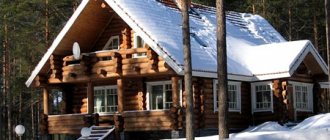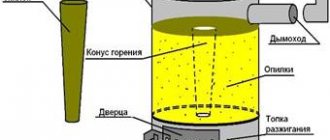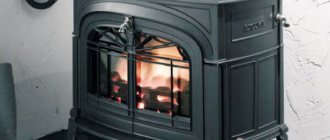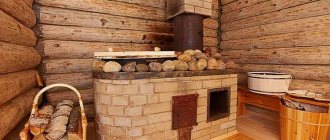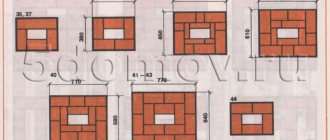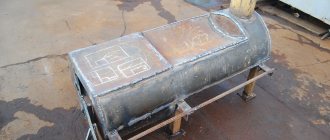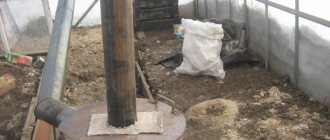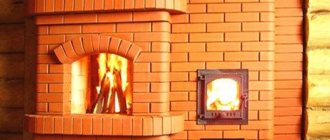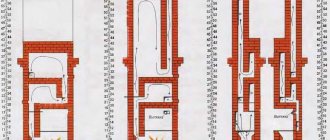The correct choice of heating system for the greenhouse determines how profitable the early cultivation of vegetables, berries or herbs will be for you. After all, the cost of heating a structure can “eat up” the lion’s share of sales revenue! The issue of cheap heating becomes no less pressing if greenhouse cultivation is conceived “for oneself”, and not for the purpose of creating a business. Based on these considerations, a greenhouse stove is the most efficient source of thermal energy. The main thing is to choose the right oven/
Furnace models
Vologda
- The principle of operation resembles a gas generator; such a stove for a long-burning greenhouse is economical to operate and has high heat output.
- It is enough to do the laying of firewood two to three times a day. Depends on the volume of the firebox and the overall size of the device.
Thanks to this, the equipment has received a great advantage, since there is no need to constantly be near the firebox and monitor the combustion.
Vologda efficiency is approximately 80%. The coolant enters from the rear through specially installed flexible hoses that connect the device to the water tank. The liquid heats up to 60 degrees from zero in 40 minutes.
There are models that can simultaneously heat a greenhouse and a residential building, in which the heat will be distributed through water heating radiators. The instructions that come with the model describe this process in detail.
Plus
It should be noted that the process of switching from the gas-generating state to the normal heater mode is easy. Therefore, the equipment can also be used for baths.
Minus
Requires periodic liwa.
Buleryan
It is used quite rarely for greenhouses and greenhouses. A convection type oven can maintain the desired temperature for a long time.
Works on regular firewood and wood products. Naturally, the price of such a device is higher than a regular “potbelly stove”.
"Bulleryan" in the greenhouse
Minuses
- Temperature regulator not installed.
- Not very convenient to install.
- The firebox needs to be monitored frequently.
In appearance it resembles a horizontal barrel, with exhaust pipes located at the bottom and top. The smallest model is capable of passing up to 5 m3 of air per minute, but the body, coated with special paint, does not heat up.
Slobozhanka
The design is well suited for a small room. You can do it yourself without the help of helpers.
Previously
- Take a thick-walled pipe, make longitudinal grooves in it with a “grinder” or “autogen”. This will be a special device for uninterrupted air supply and activation of fuel combustion.
Air duct from a 100 mm pipe
- Install a metal penny made of 5 mm steel at the bottom of the device, which will act as a gate, and it will be possible to regulate the oxygen supply to the furnace.
Device for regulating air supply to the furnace
- Make a chimney in the upper part of the firebox from a piece of pipe with a diameter of 100 mm to remove combustion products.
- Take a thick-walled metal cylinder with a diameter of 250 mm.
- Cut a 100 mm hole in the center of a thick-walled steel sheet and weld it to the pipe of the future air duct.
- Make a heat-dissipating disk from a 10 mm thick sheet of metal that will be installed inside the device.
Infrared heaters as one of the best options for heating
Infrared lamps have their own peculiarity that allows them to be considered a worthy and economical heating option: their heat spreads to plants and water containers, since the thermal elements they emit affect the liquid medium. Greenhouse walls, shelving, equipment, and other objects do not absorb the heat of infrared radiation.
Heating a polycarbonate greenhouse with infrared heaters has a number of advantages:
increase in yield up to 40% due to the complete absorption of heat generated directly by the plants;- with the help of regulation, you can create different temperature zones inside one room, which allows you to grow crops with different heat needs;
- heaters simultaneously serve as heating and lighting devices;
- they have a silent operation mode, without emitting odors and gases;
- the directed action creates the most comfortable conditions for the plants - they heat up, and the space around them remains cool.
The heat emanating from infrared (IR) heaters reaches a soil depth of 60-70 cm, which has a positive effect on the development of the root system of plants.
When using infrared heaters in polycarbonate greenhouses, they do not require additional thermal insulation. The presence of good sealing allows even the coldest areas to be heated evenly; they simply will not be there. With top heating, the lamps are suspended from the ceiling; if it is necessary to provide bottom heating, they are installed under shelves or racks on metal, specially prepared elevations.
The lamps must be placed at a distance of at least 1 m from the plants. As the seedlings grow, the lamps are raised to maintain the required distance.
A few tips to help you use IR more economically
To increase the efficiency of the devices, they are placed in a checkerboard pattern, which then leaves fewer areas without heating. The method is used if necessary to heat the entire area of the structure.
If it is necessary to provide heat to a certain area, the units are distributed directly above it.
A quality product cannot have a low price. Responding to an offer to purchase a profitable infrared heater can turn out to be a waste of money.
Heating for a polycarbonate greenhouse should, first of all, be comfortable for the plants, so you should not raise the lamps too high to heat the area more; the seedlings then receive less heat.
The industry produces IR heaters that run on liquid fuel, electricity, and gas. To minimize heat losses, it is better to place energy carriers closer to windows and doors.
Making a stove with your own hands
The choice of design for a future device mainly depends on the existing conditions and desired functions. If heating is required for a small greenhouse, the device will operate only periodically; for example, to ensure earlier sowing of seeds in the spring, a small potbelly stove of a simple design will do.
With constant use of heating, for heating large areas, a significant amount of fuel consumption, the most suitable option will be economical designs based on pyrolysis combustion. Compactness and ease of installation are important - a small steel device is easier to install and put into operation, a brick structure, due to its massiveness, will require laying a foundation, and construction work will be more labor-intensive and lengthy.
Arrangement of seedlings
We take the seedlings and arrange them so that all the plants get the light and the leaves of the seedlings do not intertwine or even touch. This is necessary to provide light and warmth. This will be the best care.
The plant is growing and needs to be planted in time in the main soil - greenhouse soil from the container, because the stems can stretch out enough and even 2-3 fruits will form on one cluster, and the plant itself will spend entirely on the formation of these particular fruits. We constantly remove small stepsons. The upper stepson can be left; it forms a second stem located next to the flower stem.
When transporting to the dacha, so that the plants do not break and feel comfortable, try not to water the seedlings a few days before transportation; it is better to dry them, the stems will not be brittle and the plant will better tolerate a stressful situation.
From the middle or end of May, you can safely begin planting tomato seedlings in a film greenhouse or greenhouse. If you have a warm greenhouse, heated, and if you have a warm heated bed, using biofuel, based on plant residues, then you can start planting tomatoes in early May. It all depends on the specific greenhouse and weather conditions.
A prerequisite for good production and good fruiting is that soil and bed preparation must be carried out immediately before planting tomato seedlings. We dig up the ridge, loosen it, level it with a rake, then you need to add mineral fertilizers so that fruiting is abundant and good.
Selection of fuel and preparation of materials
Before you buy or make your own stove for a long-burning greenhouse, you need to decide what type of fuel you will use for kindling. The most expensive to maintain are electric and gas models, since resources for them are not used economically and are expensive.
Heating, a stove and a greenhouse with the help of which will be heated economically, rationally, fully, can be carried out using the following materials:
Traditional fuel that is used in most cases.
Firewood must be well dried before use, it is the same size, and should not be very large or, on the contrary, small.
Processed products or sawdust, shavings, are likely to be found in large quantities in almost every home.
This type of fuel is especially beneficial for those who do repairs, engage in construction, and wood cutting.
A more expensive type of fuel, but it will cost much less than harvesting or purchasing firewood.
Peat burns well and economically in stoves, providing the required temperature and heat level.
Fuel can be sold either in bulk and at a lower price, or in compressed elements, in the form of coins or sausages. The second option is more convenient to use, it is portioned and economical.
Husks, straw and other fuels are processed products and therefore have a low cost.
Some give these practical materials for next to nothing or for free.
Husks can be purchased inexpensively at special enterprises that sell shelled nuts, seeds, etc.
It is important to choose the right type of heating unit, which depends on your budget. The most expensive and difficult to implement are Buleryan and Butakova, they are of course very good in terms of heating, but they will only pay off if they are installed in the house
You can assemble a convection or gas generator oven with your own hands according to the diagrams that are left by professional stove makers and amateurs on the relevant websites and forums. However, the best, optimal option would be to order an individual project from a designer or stove maker.
For more efficient and rational heating, it is best to make or buy a metal stove for the greenhouse, not a brick one; it heats up faster, accumulates thermal energy well, and distributes it evenly throughout the greenhouse.
At the first stage of work on the manufacture of the heating unit, it is necessary to assemble its main part - the body; this can be done using one of the following options:
- A cylindrical body is welded from sheet steel;
- Empty propane gas cylinders are often used as a base, which are cut to the required shape and size;
- From a pipe with a very large diameter;
- The classic option is to assemble a greenhouse stove frame from a metal barrel that has no cracks and is completely sealed. If a large barrel is taken as a base, as an addition to it for making a base, it will be necessary to buy and prepare a medium-length pipe that is necessary for making a chimney. To fasten and fix the box, you need to acquire a steel angle, reinforcement, strip or channel.
Features of modern products - a hidden threat
What is the reason? I think, first of all, in the recent publications on the pages of newspapers and magazines, as well as on television screens, about what modern sellers of “healthy” products feed us. As it turned out, for the most part, all these beautiful and appetizing delicacies do not always bring the desired benefits to the human body, and in some cases they can cause serious harm to the body, even death. In addition, it is much more pleasant to see vegetables and berries on your table that were picked just a few minutes ago from the garden, without pesticides or other chemical additives. The benefits of such products are undeniable.
Heating boilers based on potbelly stoves
To heat a multi-room house, you will need a flow-through water heating circuit with a long-burning solid fuel boiler. Such a system can be configured in two ways. The principle underlying the potbelly stove is taken as a basis.
The first method or boiler No. 1
The natural vortex is replaced by forced pressurization, and pyrolysis is divided into two stages in space: a pyrolysis chamber, a nozzle (nozzle) that forms a flow of pyrolysis gases, and a combustion chamber. The nozzle is made so that there are no parasitic turbulence behind the mass of fuel. To ensure complete control over the process, through blowing is necessary.
Features of direct-flow and heat-storing pyrolysis boilers:
- The temperature in the combustion chamber is a parameter necessary to control the process.
- Optimization of heat dissipation is directly proportional to the intensity of the boost.
- The system is insensitive to the temperature of the walls of the combustion chamber, so the water heater can be installed in a technically convenient way.
- Additional loading is possible at any stage and in any acceptable quantity.
The efficiency of once-through boilers can be above 90%. They require power to operate. When switching off, to further start the system, it is necessary to remove the sintered mass and make a new filling in the firebox.
The second method or boiler No. 2
A pyrolysis boiler with a water heater, which does not require electricity or automation, works on the principle of counteracting the two laws of the square-cube. This refers to the filling of fuel and the lining of fireclay bricks. Brick kiln operation algorithm:
- At the beginning, the intensity of the pyrolysis process is ensured by the sublimation of the lightest volatiles. The “first heat” travels through the smoke circulation, being absorbed by the lining.
- At the stationary stage, the lining serves as a thermal buffer: when there is excess pyrolysis heat, it absorbs it and releases it when it cools.
- Upon completion of carbonization of the fuel, heat is gradually released by the lining, preventing the temperature from falling below the critical point.
in or coal into a boiler with a thermal buffer is produced gradually. Sharp temperature fluctuations are contraindicated for her. If too sluggish fuel is used, it may stall. If it is too flammable, there is a risk of an emergency. If the first heat is not suppressed, the efficiency will not exceed 76-78%, since instantaneous heat transfer from the lining to the outside is excluded.
Greenhouse stove manufacturers
You can make a stove for a greenhouse yourself, or you can buy it in specialized stores, decide for yourself.
Currently, manufacturers offer many different options for greenhouse stoves:
- Buleryan.
- Butakov's stove.
- Slobozhanka.
- Vologda.
Let's consider these models in detail.
You can regulate the process of air supply into the combustion chamber using a damper. Thanks to it, you can increase or decrease the volume of oxygen supplied, which affects the final combustion rate.
Buleryan
People rarely choose such stoves for heating greenhouses, but these units guarantee long-term combustion of fuel and maintain a comfortable temperature.
Construction of the Buleryan furnace
Buleryan is a convection-type device in the form of a barrel with extended tubes, the fuel for which is firewood. It also contains:
- door for loading firewood;
- smoke damper;
- draft regulator
Externally, the Buleryan stove resembles a classic “potbelly stove”, but the principle of operation is different.
Heat exchange is carried out by:
- thermal radiation;
- heat transfer;
- convection.
In fact, it contains three devices that have different functional purposes:
- heater;
- bake;
- gas generator.
They function as follows: firewood smolders in the chamber, pyrolysis gas is produced and burned, thanks to this the process of heat transfer is carried out.
These furnaces were developed in Canada, and the German company has a patent for the production of such devices. In Russia, Buleryan is produced under the name Breneran; in terms of technical parameters, the Russian rebranding is no different from the original.
Despite the ease of use of such equipment, it has some disadvantages:
- are not equipped with regulators to adjust the temperature;
- not easy to install;
- their work must be constantly monitored.
Their price varies from 8,000 to 25,000 rubles.
https://youtube.com/watch?v=3egYpX2IPns
https://youtube.com/watch?v=3egYpX2IPns
Butakov stove
These are conventional stoves, named after the professor by whom they were developed.
The design of Professor Butakov's furnace
The furnace body is a parallelepiped, it contains air duct pipes and a two-chamber firebox. In addition, the device is equipped with:
- ash pan;
- flap;
- chimney.
The operating principle of this type of stove for greenhouses is absolutely identical to the Buleryan stove.
Price of such devices: 10,000 - 35,000 rubles.
Slobozhanka
Slobozhanka is characterized by high quality and efficiency. This type of stove is also called “super potbelly stoves”.
Slobozhanka stove
Structure:
- the combustion chamber;
- air supply and distribution channel;
- convection shirt.
In this stove, the ignition system is top-based; accordingly, logs are also loaded through the top; in addition, a special cylinder is used that exerts pressure on combustible materials.
There are three main types of these furnaces:
- With an L-shaped pipe for lateral oxygen supply into the combustion chamber.
- With air supply through the central part using a guide pitoid.
- With air supply from the lower side part.
Regardless of how air is supplied to the combustion chamber, the heat exchange process will be carried out with maximum efficiency.
You can connect a water circuit to Slobozhanka and create a heating system with radiators.
Slobozhanka is a profitable solution for heating greenhouses, since various materials can be used as fuel, from firewood to pine cones.
https://youtube.com/watch?v=DHXc7EKmD30
Vologda
Furnace Vologda
This model of long-burning stoves for heating greenhouses has a number of advantages:
- high heat transfer;
- high efficiency 80 - 90%;
- it is necessary to lay firewood several times a day;
- low price.
If you choose such a stove, you will not need to monitor how it functions all the time. To supply the coolant, flexible hoses are used, which are attached to the back of the boiler and connected to the coolant tank. For the water to heat up to a temperature of 60°C, 30-40 minutes will be enough.
Cost: 4,000 - 6,000 rubles.
The Vologda brand manufacturer produces models that can simultaneously be used for heating both greenhouses and private houses; for this you will need to connect a water circuit and install radiators.
Infrared heaters and heating boilers can also be used to heat the greenhouse.
Slobozhanka
Another stove for heating greenhouses, characterized by quality and efficiency. In this device, fuel, in particular logs, is loaded vertically. As an addition, the greenhouse stove is equipped with a special cylinder. This element presses on the fuel, as a result of which the logs fall down as they burn.
It is possible to connect a water circuit to the device, which allows you to create a heating system with radiators.
Bubafonya
Potbelly stoves have low efficiency and require frequent refilling of fuel. Craftsman Bubafonya came up with a homemade design that differs in the principle of fuel combustion.
Features and device
The main difference in the Bubafoni stove is the upper intake of the air mass, which led to such positive properties as:
- longer fuel combustion;
- there is no need to frequently load the firebox;
- better heat retention;
- economical, because such a stove can be made from scrap materials: barrels of iron or metal; You can use not only firewood as fuel, but also boards, chips, cardboard or shavings. The Bubafonya stove also works autonomously, that is, without the use of electrical energy.
There are also disadvantages to this design:
- looks unpresentable in appearance;
- average heat transfer;
- carbon formation on the walls of the furnace;
- condensation forms, which freezes in winter and blocks the main pipe;
- during air intake, fire sometimes appears from the air duct;
- When installing such a stove, it is necessary to take care of ventilation in the greenhouse.
To make Bubafonya yourself, you need to know the structure and operating principle of the stove. Air enters through the top pipe and the fuel begins to burn. When burned, ash will accumulate on the surface of the fuel and prevent it from burning. Because of this, you need to take care of installing the press in the form of a metal pancake, the diameter of which is slightly smaller than the barrel. A hole is drilled in the middle of the pancake for an oxygen pipe.
The fuel burns and the press lowers, displacing the ash between the pancake and the wall. Such ash cools down and leaves through the chimney with the rest of the combustion products.
Manufacturing
After studying the drawings and diagrams of the stove, understanding the principle of operation, you can make Bubafonya with your own hands. An important point is the choice of container. It can be used as a large diameter pipe, a barrel, or an empty gas cylinder.
Whatever it is, you will have to finish the design:
- get rid of the lid;
- to obtain a container with an open top, you need to weld the bottom;
- preparing the press: a metal sheet circle is suitable for this;
- drill a hole in the center for the pipe and attach the pipe by welding;
- a pipe with a large diameter is also welded onto the cover so that the first pipe can slide freely;
- to create a gap so that air can pass between the surface and the fuel, attach a metal profile to the pipe;
- for the firebox, make a door from an iron sheet and attach it;
- Make a hole for the chimney on top of the container and attach a pipe;
- make legs for the stove if the bottom is not “standing”.
When making a chimney, it is necessary to take into account the need to create resistance, which will allow longer heat retention.
Before installing the furnace, it is necessary to make a foundation of bricks and a substrate of galvanized sheet for it. This will help avoid heating the bottom of the stove, which leads to the death of nearby crops. The foundation also retains and distributes heat.
After installing the stove, it is necessary to line it with bricks to improve heat transfer.
Video description
About the stove after two years of use in the following video:
- Multifunctionality. Modern models delight with thoughtful functionality. There are options that can switch to another fuel (coal or wood waste). Many models can be used not only for heating, but also for cooking or heating water.
- Safety. Properly installed (according to SNiP rules) stoves comply with all safety standards, regardless of design and material of manufacture. Many units have the ability to regulate the combustion or afterburning of gases.
- Appearance. A wood-burning stove can become a decoration for your home. Manufacturers offer options for interiors decorated in any style. You can purchase a model in a modern, strict and rational design, or in a national design, using spectacular details (even hand-painted tiles).
Tiles resistant to high temperaturesSource versace-promo.ru
Many people consider the disadvantages of wood heating:
- Features of brick kilns. Such structures are famous for their ability to retain heat for a long time, which is ideal for a house in which they live permanently (or for a long time). For houses where they spend 1-2 days, the metal option is more suitable.
- Size. A bulky stove will take up a lot of precious space in a small house; a small one may not cope with heating if its capabilities are not designed for spacious housing.
- Difficulty in ensuring security. An open flame is not only beautiful, but also carries an increased risk of fire and therefore requires constant attention. Installing the stove on a prepared base and protecting it with metal foxes does not seem like a fairly safe option to everyone.
Wood stove for heating a house with a dedicated place for firewoodSource illinoisnow.org
- Fuel. The firewood must be of proper quality (dry), otherwise the stove will not last long. An improper firebox also increases costs.
- Additional problems. Not everyone is ready to put up with the fact that firewood takes up too much space, and the stove needs regular (too frequent) cleaning. In some cases, a wood-burning stove becomes not an economical option at all (if the owners have forgotten that not only firewood costs money, but also its delivery).
Wood burning stoves for heating the greenhouse
The choice of heating appliance options for a greenhouse is as varied as for a home. Most often, factory models are used, which are purchased in stores, but it is possible to make such a device yourself.
Stoves differ both in the type of fuel - wood, gas or electric, and in the material of manufacture - metal or brick.
Most often, for self-construction, a solid fuel apparatus is chosen, which is heated with firewood, pallets of wood chips, husks, and dry pieces of peat.
Conventional greenhouse stove
This type of device can be made of metal or brick.
A metal potbelly stove is quite simple to build; it is recommended to weld it from an old barrel or gas cylinder, measuring 1.5 m x 0.5 m. A distinctive negative feature will be the inability to retain heat, therefore, as soon as the fuel in the potbelly stove burns out completely, the greenhouse begins to dry out .
The uneven heating is important - the stove has a high heat transfer due to the metal body, so the air in the immediate vicinity of it becomes very overheated, which negatively affects the soil and plants.
Building a brick stove will allow you to obtain longer, gradual heating of the room, as well as long-term heat transfer after the wood has already burned out. The construction of an elongated horizontal smoke channel will significantly increase these indicators.
The dimensions of such a device can be different, depending on the area of the room; the smoke channel is usually laid out along the entire length of the greenhouse - being located in the center, it contributes to high-quality, uniform heating of the air.
Important! The task of a greenhouse stove is primarily to warm the soil, so the smoke channel and the device itself are located as close to the ground as possible
Diagram of a long-burning device
To increase the efficiency of the stove, they often equip it with a double combustion chamber - this allows you to extend the effect of one load of firewood by 12-18 hours. This is achieved through the process of pyrolysis - due to the controlled entry of air into the firebox, the firewood does not burn in an open flame, but smolders very slowly, releasing a large amount of smoke and hot gases. The second chamber of the furnace serves for the final combustion of the released combustion products.
Photo 1. Diagram showing the design of any long-burning furnace with a limited supply of oxygen.
With this heating method, you have to add fuel much less often, and pyrolysis combustion leaves almost no waste, so you don’t have to frequently clean the firebox from ash. Saving fuel and time required for maintenance makes this option the most popular. The dimensions can be quite small - 1.5 m x 1 m; more efficient heating of the air will be ensured by installing a horizontal smoke channel.
Principle of operation
When organizing stove heating for a greenhouse or greenhouse, you should first pay attention to the presence of a vestibule, an effective ventilation system and gas exhaust in the existing structure. The working principle of finished stoves may differ depending on the type of construction.
But in general, the processes occurring inside look like this:
- Cold air flows enter through the pipe of the upper part of the furnace, complemented by a damper.
- The lower compartment is filled with as much fuel as possible and set on fire, but since the flow of oxygen to it is limited, the wood chips or wood smolder more than they actually burn.
Simply put, in order to prolong the combustion process of the material used, you need to regulate the air supply, at the right time limiting its entry into the furnace.
With little exposure to oxygen, firewood takes a long time to smolder. Important! In addition to heating the air space of the greenhouse, such a stove, when connected to a water circuit, will provide heating of the irrigation fluid.
Long burning stove
Long-burning units operate on the gas-generating principle, which results in reduced fuel consumption and a low heating temperature of the device walls (read: “Long-burning heating stoves - choosing the best option”).
The all-welded design has an internal compartment consisting of two compartments:
- combustion chamber (the access of oxygen to it is limited, so the fuel smolders and does not burn, thereby increasing the combustion time of the wood);
- afterburner chambers (combustion products burn in it).
Convection pipes pass under the steel casing of the device. They ensure the exit of the heated air flow and its distribution throughout the greenhouse. Since the temperature throughout the building is almost the same, condensation does not occur. One of the advantages of long-burning stoves is that the air heats up quite quickly. Homemade long-burning potbelly stoves are also often used for heating greenhouses.
Such a unit is sufficient for heating greenhouses that are not intended to be used in winter (read: “Heating a greenhouse in winter - basic principles”). If you intend to use the building in winter, then in addition to installing a stove, you also need to lay water pipes to heat the greenhouse in winter. Devices with a built-in boiler are suitable for this purpose.
Heating systems that use long-burning stoves have many advantages over other methods of heating greenhouses:
In addition, long-burning stoves can be used effectively at any time of the year.
Wood stoves are not the best option for heating greenhouses, but they are still in considerable demand. Modern heating systems are more efficient, but their use is not always possible. If there is no access to a gas pipeline, and there are frequent interruptions in electricity, wood stoves will be the only way out of this situation.
Feeding seedlings
If we have good soil, then fertilizing can be done only as needed. If we see that the plant is very pale, then this will tell us about a lack of nitrogen. You can use nitrogen fertilizers (urea, ammonium nitrate), but it is better to use a small concentration of fertilizer when watering, water not just with water, but with a small content of nutrients, based on a teaspoon of complex mineral fertilizer per 1 liter of water. Tomatoes are very responsive to phosphorus and potassium, so it is necessary to periodically extract superphosphate and fertilize with only phosphorus.
Solid fuel stove potbelly stove
Outside cities, firewood is the most affordable, so the most popular long-burning stove is a wood-burning stove. They heat it not only with firewood from the ridge, but also with waste wood - shavings, sawdust, waste fiberboard and chipboard, small brushwood, straw, etc. There are many heating systems using wood and wood waste. Let's consider the most efficient ones, the efficiency of which is more than 70%.
A potbelly stove is an economical stove that appeared in Russia after the revolution, during the times of military communism, when many had to endure hardships. The genius of the potbelly stove is that it warms up instantly, as well as the simplicity of its design, the prototype of which was the Russian stove. The upper door is for storing firewood, the lower one is for regulating combustion by supplying air through the slightly open door.
The purpose of a potbelly stove: to keep at least one room warm at minimal cost. When using coal, the grate is removed, and air from the ash pit is directed into the firebox
It is important not to overcrowd it - the volume of the bookmark should be no more than a quarter of its volume. The afterburning chamber is a long horizontal or slightly inclined part of the chimney
Made of metal, it retains heat in the room.
When fired, any potbelly stove becomes red-hot, so its upper surface can be used as a cooking surface. A screen should be installed on the sides at a distance of 40-60 mm from the stove. It protects the room from IR rays and maintains the temperature at an optimal level.
Using a potbelly stove, you can make a homemade long-burning wood-burning boiler. To do this, instead of a screen, a U-shaped metal water heater is installed. The distance between the furnace body and the boiler should be the same as the screen indentation.
Sources
- https://eteplica.ru/otoplenie-i-ventilyaciya/kak-sdelat-pech-dlitelnogo-goreniya-dlya-teplicy.html
- https://teplofan.ru/pechi-i-kaminy/pech-dlya-teplic
- https://kotel-otoplenija.ru/pechi-dlitelnogo-goreniya-dlya-otopleniya-zimnix-teplic-kratkij-obzor-modelej
- https://teploguru.ru/pechi/pechi-dlitelnogo-goreniya.html
- https://KaminGid.ru/pech-slobozhanka-svoimi-rukami
- https://SdelayPechi.ru/vidy/firmennye/pech-slobozhanka.html
- https://kaminguru.com/pech/slobozhanka.html
- https://oteplicah.com/kommunikacii/otoplenije/76-pechi-dlya-teplic-dlitelnogo-goreniya
